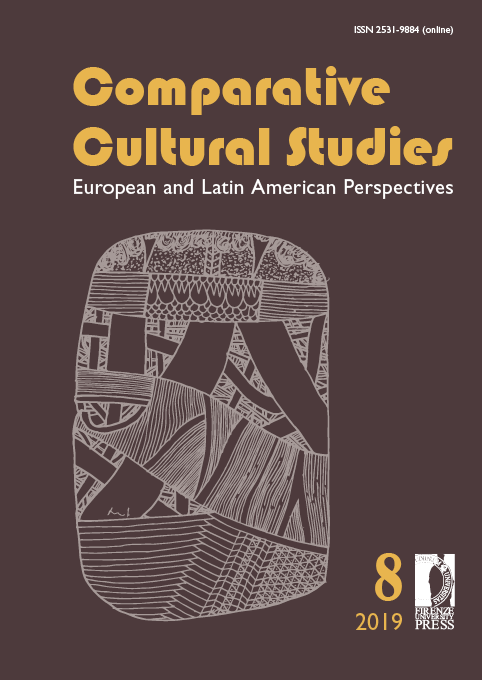“The Commission” La comunicazione su due binari paralleli
DOI:
https://doi.org/10.13128/ccselap-10866Keywords:
Migration, asylum seekers, ethnography, communicationAbstract
This paper explores the gaps in communication, which may take place during the administrative procedure to asylum seekers in order to evaluate their request for protection under international law. Starting from ethnographic research carried out at refugee centres in the province of Ferrara (Italy), the analysis will focus on the normative linguistic register used, according to national and international guidelines, by the Territorial Commissions. Comparing them with the process of interviewing, and other case-studies, this research stresses some recurring narratives and possible asymmetries that could arise during the conversation between the Commission and asylum seekers with their life histories. As emerged here, the complexity and the limits of this communicative interaction, especially during the interviews, is not limited to the moment of examination, but lead to broader forms of social discrimination.
Downloads
References
AA.VV. (2004). Istanbul Protocol. Manual on the Effective Investigation and Documentation of Torture and Other Cruel, Inhuman or Degrading Treatment or Punishment. New York e Ginevra: UNHCR.
AA.VV. (2011). Handbook and guidelines on procedures and criteria for determining refugee status. Under the 1951 Convention and the 1967 Protocol relating to the Status of Refugees, Geneva: UNHCR.
AA.VV. (2016). Intervistare i richiedenti asilo, Alto Commissariato delle Nazioni Unite per i Rifugiati, Roma: UNHCR.
Agamben, G. (1995). Homo sacer. Il potere sovrano e la nuda vita. Torino: Einaudi.
Agier, M. (2009). Le Camp comme Limite et come Espace Politique. In: Makaremi C. e Kobelinsky C. (a cura di), Enformés dehors. Enquêtes sur le Confinement des Etran-gers. Paris: Terra, pp. 27-40.
Algostino, A. (2018). Il Decreto «Sicurezza e Immigrazione (Decreto Legge n.113 del 2018). Estinzione del diritto di asilo, repressione del dissenso e diseguaglianza. Costituzionalismo.it, 2,165-199.
Aloh, E. G. (2015). Engaging the unwritten text: the role of orality and popular culture in the social engineering process of postcolonial Nigeria. Peterborough: Trent University.
Blommaert, J. (2009). Language, Asylum, and the National Order. In: Current Anthropo-log y, 50(4), 415-41.
Bourdieu, P. (1995). Ragioni pratiche. Bologna: Il Mulino.
Cabot, H. (2013). The social aesthetics of eligibility: NGO aid and indeterminacy in the Greek asylum process. American Ethnologist, 40 (3), 452-466.
Ciabarri, L. (2013). Oltre la frontiera Europa:ascesa e declino della rotta migratoria Libia-Lampedusa e forme di mobilità dal Corno d’Africa (2000-2009). Antropologia – Migrazioni e asilo politico, 15, 63-83.
Cutolo, A. (2017). Collaborare o rigettare? L’arcipelago dell’accoglienza e il «mestiere d’an-tropologo» Dibattito: la risposta di Armando Cutolo. Antropologia Pubblica, 3 (1), ISSN: 2531-8799, 201-207.
Fabris, A. (2006). Etica della comunicazione. Roma: Carocci.
Fassin, D. (2006). Un ethos compassionevole. La sofferenza come linguaggio, l’ascolto come politica. Antropologia, 8, 93-111.
Fassin, D. (2006). La biopolitica dell’alterità. Clandestini e discriminazione razziale nel dibattito pubblico in Francia. In: Quaranta I. (a cura di). Antropologia medica. I testi fondamentali. Milano: Raffaello Cortina Editore, pp. 303-322.
Feuba, W. E. (2009). The sociolinguistics of mobile phone SMS usage in Cameroon and Nigeria. The International Journal of Language Society and Culture, pp. 25-41.
Gatta, G. (2012). Corpi di frontiera. Etnografia del trattamento migranti al loro arrivo a Lampedusa. Rivista della Società italiana di antropologia medica, 33-34, 129-162.
Kirmayer, L. (2003). Failures of imagination: The refugee’s narrative in psychiatry. Anthro-pology & Medicine, 10 (2), 167-185.
Malkki, L., (2002). News from nowhere. Mass displacement and globalized «problems of organization». Ethnography, 3(3), 351-360.
Mencacci, E. (2015). Tra tecnologie del ricordo e produzione di verità: memoria e narra-zione nelle politiche di asilo. Enciclopaideia, XIX (41), 61-82.
Mugnaini, M. (2017). Tra attivismo militante, mandato professionale e posizionamento di ricerca. Considerazioni e proposte su l’operatività congiunta nell’accoglienza dei richiedenti asilo. Antropologia Pubblica, 3(1), 91-103.
Ong W. J. (1986). Oralità e scrittura. Bologna: Il Mulino.
Pilotto, C. (2018). Politiche dell’accoglienza. Lavoro, welfare e diritti di cittadinanza nell’Europa dell’asilo. Antropologia Pubblica, 4 (2), 157-166.
Pinelli, B. e Ciabarri, L. (a cura di) (2015). Dopo l’approdo. Un racconto per immagini e parole sui richiedenti asilo in Italia. Firenze: editpress.
Pinelli, B. (2010). Soggettività e sofferenza nelle migrazioni delle donne richiedenti asilo in Italia. In: Ribeiro Corossacz V., Gribaldo A. (a cura di) La produzione del genere. Ricerche etnografiche sul femminile e sul maschile. Verona: Ombre Corte, pp.135-55.
Pinelli, B. (2016). Forme del controllo: i centri per richiedenti asilo in Italia. Intervento presso Fossoli Foundation–Fondazione Ex–Campo. Disponibile online: http://www.centrostudifossoli.org/PDF/INTERVENTO_PINELLI. pdf. Consultato il 15/04/2019.
Saitta, P. (2017). Collaborare o rigettare? L’arcipelago dell’accoglienza e il «mestiere d’an-tropologo». Antropologia Pubblica, 3 (1), ISSN: 2531-8799, 196-201.
Sayad, A. (2002). La doppia assenza. Milano: Raffaello Cortina.
Sorgoni, B. (2013). Chiedere asilo. Racconti, traduzioni, trascrizioni. Antropologia - Migra-zioni e asilo politico, 15, 131-151.
Taliani, S. (2011). Il passato credibile e il corpo impudico. Storia, violenza e trauma nelle biografie di donne africane richiedenti asilo in Italia. Lares, Anno LXXVII, 1, 135-157.
Turner S. (2015). What is a refugee camp? Explorations of the limits and effects of the camp. Journal of Refugee Studies, 1-10.
Downloads
Published
How to Cite
Issue
Section
License
Copyright (c) 2019 Enrico Gallerani, Martina Belluto

This work is licensed under a Creative Commons Attribution 4.0 International License.
This licence allows third parties to share (copy and redistribute the material in any medium or format) and adapt (remix, transform and create from the material for any purpose, including commercial purposes), provided that authorship and first publication in this journal (The Journal, DOI of the work) is acknowledged, a link to the licence is provided, and it is stated whether changes have been made to the work.







